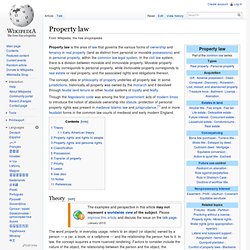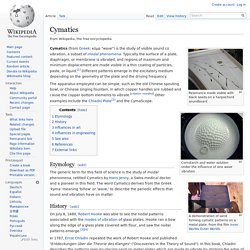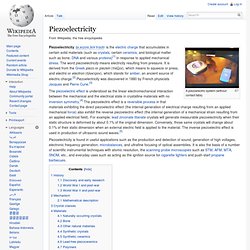

Property law. The concept, idea or philosophy of property underlies all property law.

In some jurisdictions, historically all property was owned by the monarch and it devolved through feudal land tenure or other feudal systems of loyalty and fealty. Though the Napoleonic code was among the first government acts of modern times to introduce the notion of absolute ownership into statute, protection of personal property rights was present in medieval Islamic law and jurisprudence,[1] and in more feudalist forms in the common law courts of medieval and early modern England.
Theory[edit] The word property, in everyday usage, refers to an object (or objects) owned by a person — a car, a book, or a cellphone — and the relationship the person has to it. In law, the concept acquires a more nuanced rendering. Early American theory[edit] James Wilson, U.S. In the opening sentence of "On the History of Property," he states quite clearly: “Property is the right or lawful power, which a person has to a thing.”
EDU. Video Lectures. Open Yale Courses. 21. Certification: Design and Green Architecture. Artistry and Agency in a World of Vibrant Matter. Cymatics. Resonance made visible with black seeds on a harpsichord soundboard Cornstarch and water solution under the influence of sine wave vibration Cymatics (from Greek: κῦμα "wave") is the study of visible sound co vibration, a subset of modal phenomena.

Typically the surface of a plate, diaphragm, or membrane is vibrated, and regions of maximum and minimum displacement are made visible in a thin coating of particles, paste, or liquid.[1] Different patterns emerge in the excitatory medium depending on the geometry of the plate and the driving frequency. The apparatus employed can be simple, such as the old Chinese spouting bowl, or Chinese singing fountain, in which copper handles are rubbed and cause the copper bottom elements to vibrate.
[citation needed] Other examples include the Chladni Plate[2] and the CymaScope. Etymology[edit] History[edit] On July 8, 1680, Robert Hooke was able to see the nodal patterns associated with the modes of vibration of glass plates. Piezoelectricity. A piezoelectric system (without contact tabs) Piezoelectricity is found in useful applications such as the production and detection of sound, generation of high voltages, electronic frequency generation, microbalances, and ultrafine focusing of optical assemblies.

It is also the basis of a number of scientific instrumental techniques with atomic resolution, the scanning probe microscopies such as STM, AFM, MTA, SNOM, etc., and everyday uses such as acting as the ignition source for cigarette lighters and push-start propane barbecues. Cooking up piezo crystals at home. Preparation of Rochelle Salt (Potassium Sodium Tartrate) Here you will learn how to prepare Rochelle salt from baking soda and cream of tartar, which are available from a grocery store.

Here's what you need 500 g (1 lb) of baking soda (sodium bicarbonate)[NaHCO3] 200 g (7 oz) of cream of tartar (potassium bitartrate)[KHC4H4O6] [see note below] Oven Pyrex container Jar with lid 500 mL (2 cup) glass beaker or Pyrex measuring cup Sauce pan with water 2 mL (1/2 tsp) measuring spoon Spoon for stirring Coffee Filter Filter paper or paper towelling NOTE: Some people have gone to bulk food or health food stores where they found a less expensive cream of tartar. Unfortunately, what is sold there as "cream of tartar" frequently has been NOT potassium bitartrate, but rather a mixture of calcium sulfate (Plaster of Paris), monocalcium phosphate, fumaric acid, and corn starch. This mixture definitely WILL NOT WORK. Here's what you do for the first reaction. TLP Library Piezoelectric Materials. A Crash Course In Particle Physics (1 of 2)
Environmental law. IT & computer science. Probability. Course Catalog. Introduction to Mathematical Thinking. Banach–Tarski paradox. Can a ball be decomposed into a finite number of point sets and reassembled into two balls identical to the original?

A stronger form of the theorem implies that given any two "reasonable" solid objects (such as a small ball and a huge ball), either one can be reassembled into the other. This is often stated informally as "a pea can be chopped up and reassembled into the Sun" and called "pea and the Sun paradox". Unlike most theorems in geometry, this result depends in a critical way on the choice of axioms for set theory. It can be proven only by using the axiom of choice,[2] which allows for the construction of nonmeasurable sets, i.e., collections of points that do not have a volume in the ordinary sense and that for their construction would require performing an uncountably infinite number of choices.
It was shown in 2005 that the pieces in the decomposition can be chosen in such a way that they can be moved continuously into place without running into one another.[3] They remark: